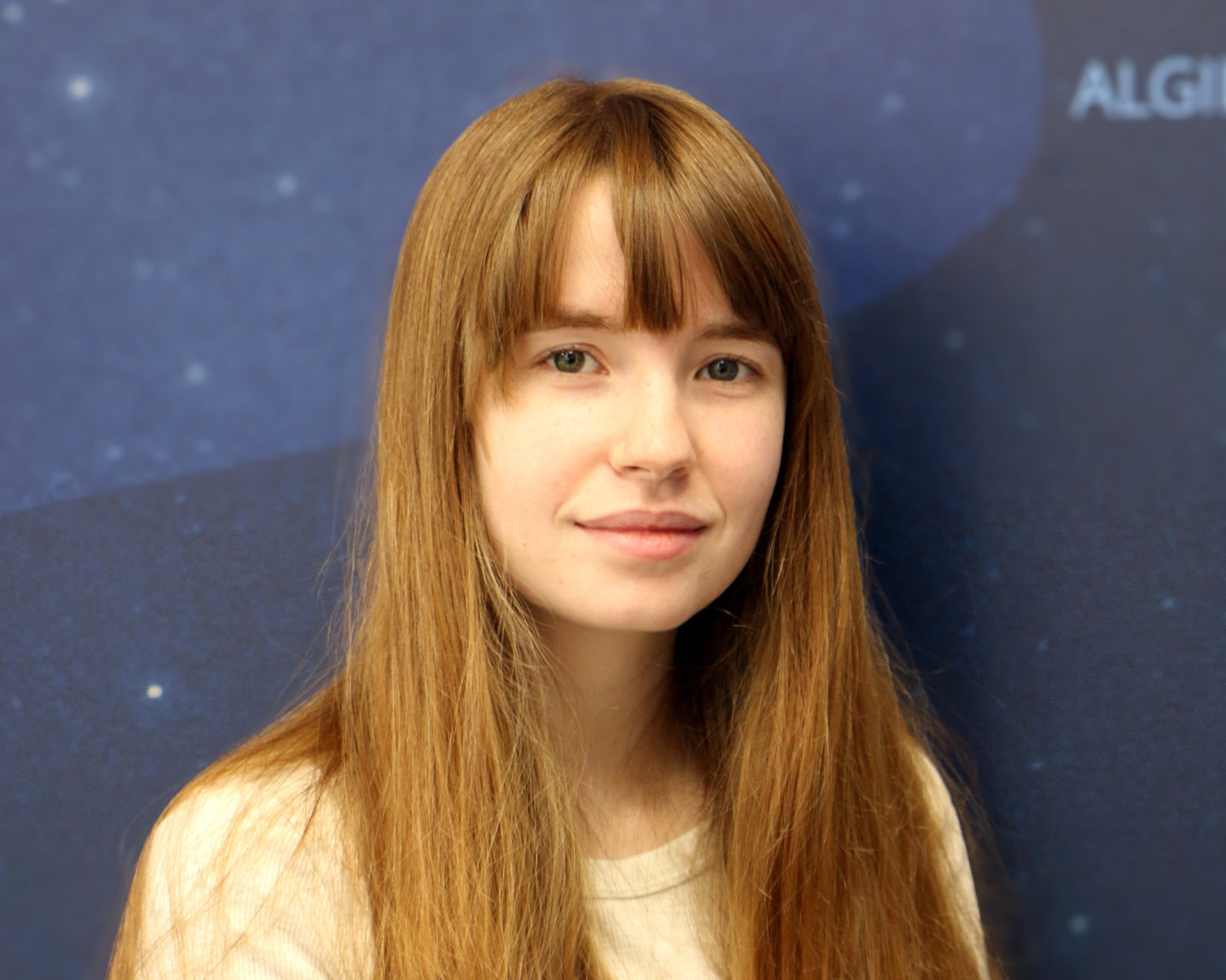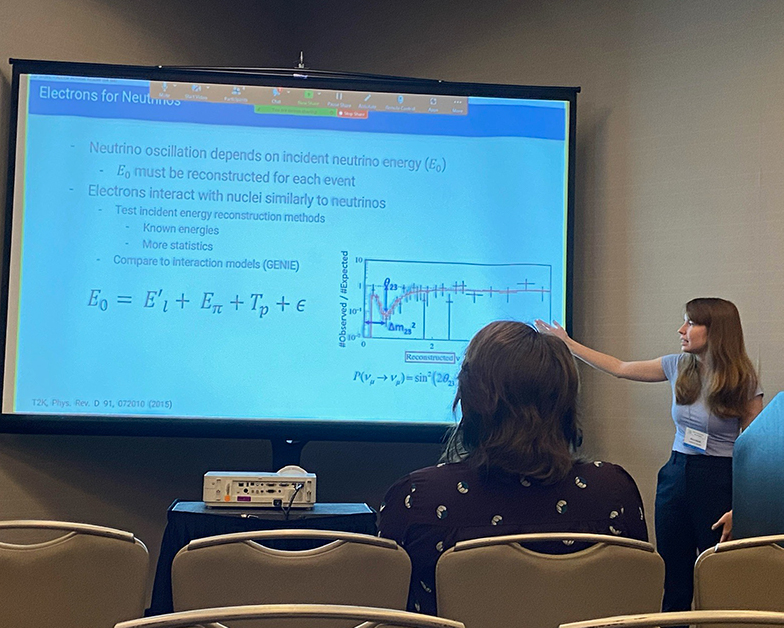As a 2022-2023 Jefferson Science Associates Minority/Female Undergraduate Research Assistantship recipient, Alicia Mand is reusing old electron scattering data to help solve the puzzle of neutrinos
Alicia Mand’s desire to explore and understand the world around her started with a telescope. As a kid, she would go with her dad to the park to gaze at the Moon.
“It was a really cheap telescope,” she said. “I couldn’t see much more than that.”
Nevertheless, these fond memories sparked a lifelong interest in astronomy. Then, when Mand took her first physics class in high school, she realized she was interested in more than just celestial objects. It inspired her to major in physics, a goal that she is now achieving as a senior at Old Dominion University.
“I was like, ‘Oh, this is even more fun than using telescopes,’” she said. “Physics just feels like this really big puzzle about the world. The more that I do physics, the more that I learn about the world on a fundamental level.”
Mand is helping solve part of that puzzle as one of two 2022-2023 Jefferson Science Associates Minority/Female Undergraduate Research Assistantship recipients. M/FURA students perform research projects that relate to the science mission of the Department of Energy’s Thomas Jefferson National Accelerator Facility.
“I feel very honored to get this assistantship,” she said. “It definitely helps out with school. I'm very thankful to have it.”
Puzzling particles
Ultimately, Mand’s assistantship project will improve our understanding of neutrinos. Though these tiny, chargeless and nearly massless particles are ubiquitous, they are difficult to study, because they don’t interact with matter often.
Physicists still have a lot to learn about neutrinos, including how they oscillate between types. There are three types of neutrinos, and as one neutrino travels, it will shift between these types or “flavors.” Studying this oscillation will also offer insights into other mysterious properties of neutrinos.
Experiments assess how neutrinos change their flavor by measuring a neutrino beam twice: First with one detector situated next to where the particle is produced, and then again with another detector located a certain distance away. However, for these experiments to properly understand how a neutrino oscillates, they need to determine its energy. And that’s not an easy task.
So far, scientists lack a good way to measure neutrino energy. Instead, they use models to reconstruct a neutrino’s energy from the particles it produces when it collides with the nucleus of an atom in a detector.
“But because you can’t directly measure neutrino energy, you’ve got no way to calibrate whether or not what you’re doing works,” said Lawrence Weinstein, professor of physics at ODU and scientific user at Jefferson Lab.
To compensate, Mand is working with Weinstein on her M/FURA project to check the accuracy of these neutrino models using a different particle: electrons.
Recycling old data for future experiments
Electrons can act as a proxy for neutrinos, because these two particles interact similarly with atomic nuclei.
“When you slam a neutrino into a nucleus ,and when you slam an electron into a nucleus, they both behave pretty similarly,” Mand said. “We are exploiting that similarity.”
Importantly, electrons are unlike neutrinos, because scientists can directly measure their energy.
Mand is using neutrino methods to reconstruct incident electron energies from 1999 data of electron-nucleus collisions at 2.2 and 4.4 GeV using Jefferson Lab’s Continuous Electron Beam Accelerator Facility (CEBAF), a DOE user facility. She’ll check the output of the models against the known electron energies to see how well they work.
“I think it's really cool that I can use electron scattering data that predates my birth in order to help improve neutrino energy reconstruction methods for future experiments,” she said.
Her work is focusing on a specific type of collision in which an electron hits a nucleus and knocks out only one proton and one pion. This will build on previous results, published in Nature, that looked at collisions where an electron hits a nucleus and kicks out only one proton.
“We found that the simulations for these collisions used by the neutrino community did not describe things well,” Weinstein said. “A lot of events, even for this very simple case, didn't reconstruct to the right energy using the current reconstruction methods.”
Mand will determine if the energy reconstruction methods used by the neutrino community for the so-called “one proton-one pion channel” are also lacking. Mand started working on this project, which is part of the international collaboration Electrons for Neutrinos, in 2020 with Weinstein, who nominated her for the M/FURA program.
“I was very impressed with her performance,” Weinstein said. “She's very hard working, she's very meticulous, and she's double-majoring in physics and computer engineering. Since this data analysis is basically a programming project, that was directly applicable.”
Inspiring others
Mand’s achievements in physics don’t stop with M/FURA. She serves as president of ODU’s Society of Physics Students. As president, Mand holds meetings and helps organize events, such as the popular Pumpkin Drop each October. She also helps arrange field trips, including last year’s trip to Jefferson Lab, and secures funding for students to attend conferences.
“It's contributed quite a bit to my success, because it pushes me to do better to be a good role model,” she said.
Her on-campus involvement includes astronomy, as well. She has worked at ODU’s planetarium since 2019. There, in addition to general housekeeping and ticketing, she presents shows to visiting groups and shares her love of space at outreach events for kids.
“I think what we’re able to accomplish from here on Earth is kind of the coolest,” said Mand. “We’re just this little dot in the universe, and we’re able to see really far out.”
After she graduates, Mand plans to attend graduate school. She hopes to either continue studying nuclear physics or pursue astrophysics to fulfill a lifelong aspiration that also began with her first telescope.
“I still haven’t outgrown that dream of wanting to be an astronaut,” she said.
The assistantship is supported by the JSA Initiatives Fund Program. The Initiatives Fund is supported by Jefferson Science Associates, which manages and operates Jefferson Lab for DOE’s Office of Science. Initiatives Fund activities further the scientific outreach, and promote the science, education and technology missions of Jefferson Lab.
Further Reading
Electrons Set the Stage for Neutrino Experiments
Investigating an Imbalanced Universe
Music Major Finds a New Rhythm in Physics
Student’s Flexibility Leads Toward Greater Mobility for Others
Lifelong Exposure to Science Leads to Career in Physics
By Chris Patrick
Contact: Kandice Carter, Jefferson Lab Communications Office, kcarter@jlab.org
Editor's Note: Updated March 7 with additional links.



